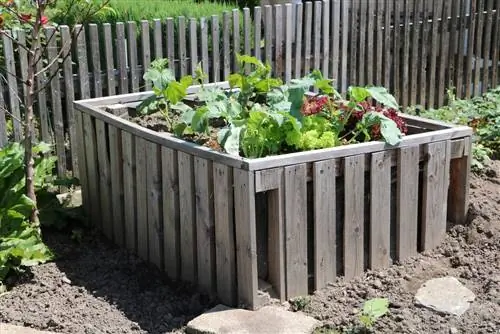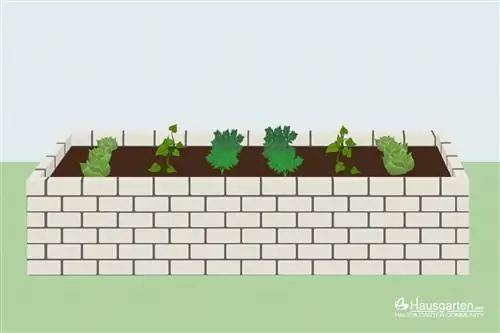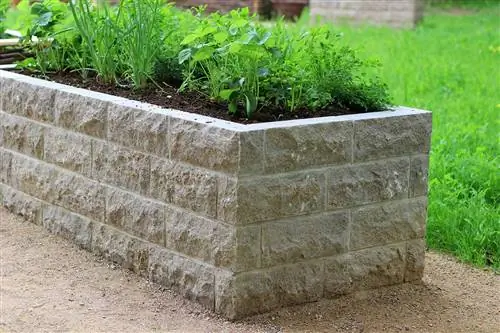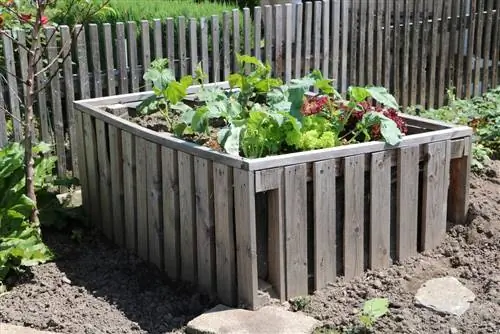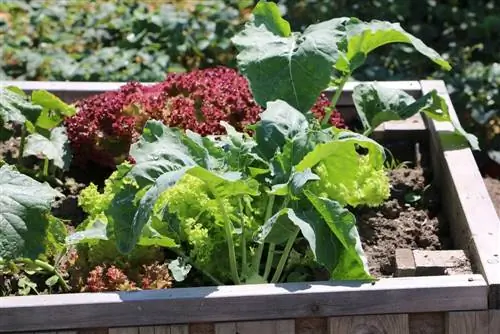- Author admin [email protected].
- Public 2023-12-17 03:39.
- Last modified 2025-06-01 06:48.
Practical, modern and back-friendly - raised beds are trendy. Anyone who owns such a system can be one of the first to enjoy crisp lettuce in the spring. And over the course of a long gardening life, the waist-high bed becomes increasingly indispensable when constant bending causes problems and your back hurts after a long day at work. However, in order for gardening with the raised bed to be successful, it is important to fill the construction according to certain aspects.
Filling the raised bed - optimal time
It is important to choose the optimal time for building and filling the raised bed; For example, both spring and autumn are particularly suitable for creating and then filling the bed. During this time, leaves or wood cuttings typically accumulate in the garden, which can be optimally used for filling. Anyone who uses natural materials from their own garden ensures that no contamination or harmful substances get into the system.
Building a raised bed
A raised bed consists of three main layers:
- Drainage
- Compost
- Substrate
No matter what type of raised bed is to be created: In any case, the filling material used becomes increasingly finer from the bottom layer to the top layer. There are branch clippings and brushwood close to the ground, compost in the middle area and potting soil at the top.
Tip:
To protect the raised bed from voles, it is a good idea to line the floor with a mouse grid.
Different raised beds for different purposes
Today the raised bed is used for many different needs. Hobby gardeners particularly often use the plant for the following purposes:
- as a vegetable patch
- for salad
- as a herb garden
- for flowers
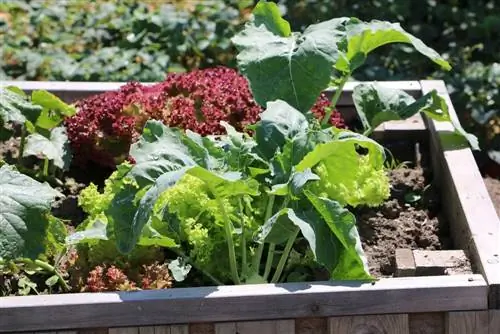
Depending on the desired uses for the raised bed, the composition of the contents can vary; So a classic flower bed gets by with a simple layering of an air-permeable layer close to the ground, compost as a middle layer and potting soil as a final layer; Plants used for vegetables typically require additional layers. If you want to use your raised bed as a small herb garden, you also have to take the different needs of the individual herbs into account; While Mediterranean plants such as rosemary and thyme prefer dry and sandy soil, local herbs (chives or parsley), for example, require fresh soil. If in doubt, the top layers of earth must be divided into different areas.
Filling a classic raised vegetable bed
Each bed is individual and has certain requirements and different structural conditions. Here we show you how to fill an example bed.
First layer: drainage layer
The first layer with which the raised bed is filled is the drainage layer; this has the following properties:
- is up to 30cm thick
- should be at least 10cm
- ensures that no water accumulates in the raised bed
- consists of stones, clay or branches
If you cut the trees in your garden in autumn, you should store the cuttings carefully; it can be used as the first layer of the raised bed. For this purpose, branches up to the thickness of an arm are roughly chopped and then laid out on the floor of the raised bed. This is followed by thinner layers of brushwood and twigs. Alternatively, rootstocks that are covered with some soil can also serve as filling material for the bottom layer. Cardboard or boxes are also suitable, although they must not be printed.
Stones and pottery shards can be used as an alternative filling for the first layer. As with layering plant material, the same applies here: the individual components become increasingly finer from bottom to top. Thick shards of clay or larger stones can be found on the bottom, which are then layered with clay granules or gravel.
Second layer: soil mixture
The first layer of substrate is distributed over the drainage layer. This location has the following characteristics:
- Thickness about 15cm
- serves to support the decomposition process of the wood core
- Garden soil or ready-made substrate can be used
The drainage is followed by a layer of sod or semi-decomposed compost, which is covered with a layer of leaves or straw or a mixture of both components. The final step is a mixture of soil and sifted compost.
Tip:
If Mediterranean plants are to be grown, the overall substrate must not be too nutrient-rich. For ornamental plants that generally stay in the bed for a longer period of time, lava or expanded clay can generally be incorporated. A pH test is also suitable, with which the soil can be checked for acidic or alkaline properties; This is crucial when choosing vegetables.

As an alternative to the substrate mixture from your own garden, you can use quality soil from the specialist market. Here too, different varieties are available for the individual plant species.
Third layer: wood core
Waste from the garden can be optimally used for the wood core. For example, the following are used:
- Remnants of bush cuttings
- thin branches and twigs
- chopped goods
- Plant residues (fruit, vegetables)
- Remnants of perennial pruning
Tip:
The individual parts used to fill this layer must not exceed a total length of approximately 40cm!
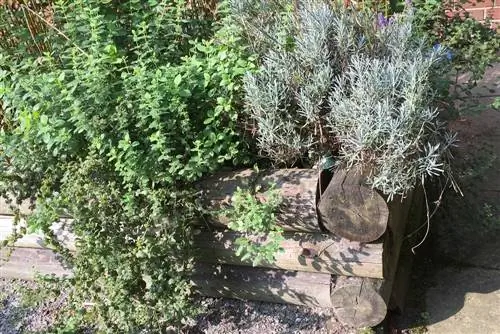
The wood core can be generous in thickness; A total of 40cm should be estimated for this location. If the layer is thick enough, this ensures that the rotting process provides sufficient nutrients and heat, which are important for the plants.
Leaves can be used to cover the wood core; the leaves should be layered three centimeters high.
Fourth layer: middle core
The middle core forms the fourth layer of a raised bed. When investing, please note the following:
- Thickness about 15cm
- Material: stable manure such as horse manure or
- coarsely rotted compost
Tip:
If you want to use compost from your own garden for your raised bed, you should never put meat or fish waste there. When composting, it is also important to ensure that no plastic parts get lost in the mixture; The compost should be 100 percent biodegradable and should therefore only contain food that rots.
In addition to the compost, the layer of the wood core can contain beneficial organisms that are specifically settled. They ensure that the compost is shredded and promote a faster rotting process. In this way, important nutrients are released for the plants. If plants that have an increased nutrient requirement are to be grown in raised beds, it is also suitable to use a slow-release fertilizer to enrich the bed. Horn shavings are primarily used for this purpose.
Fifth layer: finely sifted compost
The last layer of the raised bed is finely sifted compost, which ensures the plants' nutrient supply; In this way they can grow optimally. After harvesting, this layer can be refreshed if necessary before new plants are planted. If neither compost nor garden soil from your own garden is available, appropriate substrates can be purchased from specialist stores, for example:
- Garden soil (for salad)
- potting soil
- Mother soil (ideal for crops)
Renewal of the raised bed
The contents of the raised bed do not remain stable all year round; Over the course of the months, the entire contents of the system collapse, reducing the filling height by up to 20cm. Then fresh soil must be added. Spring is the best time for this measure, as the entire system is subjected to a thorough inspection during this time. However, the soil cannot be refilled as often as desired.
The raised bed usually needs to be replaced after five, or at the latest after 7 years. Then the following measures apply:
- Repair construction, repair damaged areas
- Replace the entire filling material
- Create stratification from scratch
Background of these measures:
After a few years, the nutrients in the filling are completely used up. This applies not only to structures that serve as vegetable beds, but also to flower beds. If you take good care of your raised bed over the years, regularly replace the filling and take care of the overall construction, you will enjoy your system for many years. Then the raised bed remains a popular highlight in the local green space. For back-friendly gardening - well into old age!

